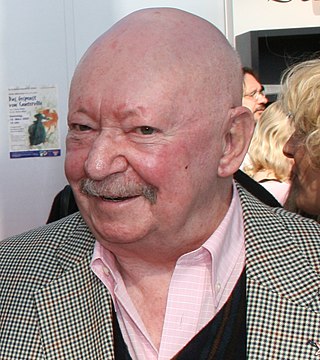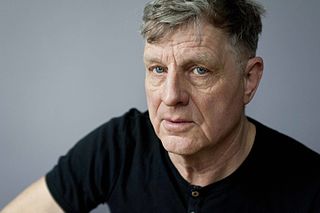Related Research Articles

Günter Kunert was a German writer. Based in East Berlin, he published poetry from 1947, supported by Bertold Brecht. After he had signed a petition against the deprivation of the citizenship of Wolf Biermann in 1976, he lost his SED membership, and moved to the West two years later. He is regarded as a versatile German writer who wrote short stories, essays, autobiographical works, film scripts and novels. He received international honorary doctorates and awards.

Ernst Wilhelm Nay was a German painter and graphic designer of classical modernism. He is considered one of the most important painters of German post-war art.

Rainer Fetting is a German painter and sculptor.

Mark Lammert, is a German painter, illustrator, graphic artist and stage designer. He lives and works in Berlin.

Will Lammert was a German sculptor. In 1959 he was posthumously awarded the National Prize of the German Democratic Republic.
Max Uhlig is a German painter. He won the Hans Theo Richter-Preis of the Sächsische Akademie der Künste in 1998.

Marcus Michael Douglas Behmer, also known by the pseudonyms Marcotino and Maurice Besnaux, was a German illustrator, graphic designer and painter. He was the first well-known German artist to publicly admit to homosexuality.
Norbert Prangenberg was an abstract painter, sculptor, and engraver who was born in Nettseheim, just outside of Cologne, Germany. Though he had no formal training and did not fully engage with art until his 30s, Prangenberg did finally come up with a style that was uniquely his own, not fitting comfortably into the neo-expressionist or neo-geo movements of his time, in the 1970s and 1980s. At this time, he was considered a major figure in contemporary German art. Though he got his start with abstract paintings, he also became known for making sculptures of all sizes; and while his work initially appears abstract, the titles given sometimes allude to the human body or a landscape. As a trained gold- and silversmith, as well as a glassblower, he always showed an attention to materials and how they could be physically engaged with. He was interested in how his own two hands could affect the painting or sculpture's surface. Traces of the artist's hand appear literally throughout his entire oeuvre, before he lost the battle with liver cancer in 2012.

Joachim Schmettau is a German sculptor.
Rudi Tröger is a German painter and university professor. From 1967 to 1992 he was a professor for painting art at the Academy of Fine Arts, Munich.

Doris Ziegler is a German painter whose work responded to and engaged with the Wende and the peaceful revolution in the GDR during the late 1980s.

Bettina von Arnim is a German-born new realist painter, illustrator and graphic artist.
Peter Betthausen is a German art historian.

Wolf Röhricht was a German painter. His work was part of the painting event in the art competition at the 1928 Summer Olympics.
Karl Krug was a German painter.
Karl Buchholz was one of Hitler's Nazi art dealers specialized in selling looted "Degenerate Art".

Georg Malin is a Liechtensteiner artist, sculptor, historian and politician. Between 1974 and 1978, Malin served as member of the governing council in the Liechtenstein government, for the Progressive Citizens' Party (FBP). He previously served as a member of the Landtag of Liechtenstein from 1966 to 1974, where he was also a member on the parliamentary delegation to the European Council.
Gitte Hähner-Springmühl is a German painter, graphic artist and musician who was part of the independent art scene of the GDR in Chemnitz (Karl-Marx-Stadt) from the 1980s onwards. (Karl-Marx-Stadt) from the 1980s.
Erich Wiese was a German art historian and museum director.

Alfred Ahner was a German painter and designer.
References
- ↑ (in German)Bruno Voigt 1912–1988. Widerstandskunst 1933–1944. AGO-Galerie, West-Berlin, page 7
- ↑ (in German)Bruno Voigt. Aquarelle, Zeichnungen, Radierungen. Ausstellungskatalog, Galerie am Sachsenplatz/Staatlicher Kunsthandel der DDR, Leipzig 1986, Kat.-Nr. 82, Abb. S. 37.
- ↑ (in German)Ich und die Stadt. Mensch und Großstadt in der deutschen Kunst des 20. Jahrhunderts. Ausstellungskatalog, Berlinische Galerie, Berlin 1987, S. Abb. 203 (Aquarell und Tinte auf Papier, Sammlung Marvin and Janet Fishman, Milwaukee/Wisconsin).
- ↑ (in German) "Drawing".
- ↑ (in German)Bruno Voigt 1912–1988. Widerstandskunst 1933–1944. AGO-Galerie, West-Berlin.
- ↑ (in German) "Kunstwiderstand. Bruno Voigts "Widerstandskunst" in der AGO Galerie". Die Tageszeitung: taz. Die Tageszeitung. 7 January 1989.
- ↑ (in German)Bruno Voigt 1912–1988. Widerstandskunst 1933–1944. AGO-Galerie, West-Berlin, page 94.
- 1 2 3 (in German) "Mein Lebenslauf (Website der Galerie Hebecker, Weimar, ohne weitere Quellenangaben".
- ↑ (in German)Bruno Voigt. Aquarelle, Zeichnungen, Radierungen. Ausstellungskatalog, Galerie am Sachsenplatz/Staatlicher Kunsthandel der DDR, Leipzig 1986, page 5.
- ↑ (in German) "Biographie auf der Website der Galerie Brockstedt" (PDF).
- ↑ (in German)Bruno Voigt. Aquarelle, Zeichnungen, Radierungen. Ausstellungskatalog, Galerie am Sachsenplatz/Staatlicher Kunsthandel der DDR, Leipzig 1986, page 5.
- ↑ (in German) "Drawing, Hitler Speaks (1929), on the Galerie Brockstedt website" (PDF).
- ↑ (in German)Bruno Voigt. Aquarelle, Zeichnungen, Radierungen. Ausstellungskatalog, Galerie am Sachsenplatz/Staatlicher Kunsthandel der DDR, Leipzig 1986, page 5.
- ↑ (in German)Bruno Voigt 1912–1988. Widerstandskunst 1933–1944, AGO-Galerie, West-Berlin, page 6
- ↑ (in German) Wolfgang Thiede, „Exkurs über Formen von Widerstand und Anpassung – damals und heute“. In: Bruno Voigt 1912–1988. Widerstandskunst 1933–1944. AGO-Galerie, West-Berlin, page 29.